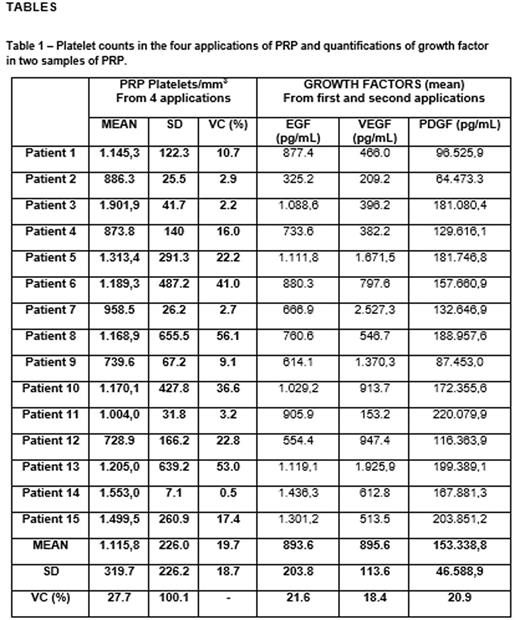Abstract
Background: Androgenetic alopecia (AGA) is characterized by a pattern hair loss. Currently, treatment with platelet-rich plasma (PRP) has shown promising results due to the growth factors (GFs) released by the platelets. However, the analysis of therapeutic response according to GFs levels and platelet number in PRP has not been established.
Objective: Investigate the therapeutic response to treatment of AGA using a standard method of PRP preparation, and the relation with GFs levels and platelet number.
Methods: Inclusion criteria comprised diagnosis of AGA-III-vertex profile according to the Norwood-Hamilton scale, age between 18 and 50 years. Exclusion criteria comprised female gender, previous hair transplantation, any disease related to hair loss such as thyroid disease and/or iron deficiency, neoplasia present or past, kidney, liver, infectious, hematologic or rheumatoid disease, use of antiplatelet and/or anti-inflammatory drugs. All patients provided written informed consent approved by the ethic committee from the Faculty of Medical Sciences of the State University of Campinas (UNICAMP).
The protocol comprised 20 subcutaneous injections of 100 µL in the scalp totaling 4 applications every fifteen days, with evaluation performed pretreatment (t0), 45 (t1) and 150 (t2) days after the start of the protocol. The endpoints for therapeutic response were hair growth and increase of percentage of anagen hairs evaluated by TrichoScan.
For each patient 40 mL of peripheral blood were collected in ACD tubes. L-PRP (PRP with leukocytes) was performed, with double centrifugation (300 g for 5 minutes, and 700 g for 17 minutes). The platelets were counted in the baseline and in the PRP samples. PRP was activated with autologous serum. The platelet-derived growth factors (PDGF), vascular endothelial growth factor (VEGF), epidermal growth factor (EGF) were measured by Luminex technique (Millipore®, USA), in two different PRP samples from each patient.
Results: During the period of August to December of 2014, 15 male patients were included in the study. The median of platelets in PRP was increased by 5 folds in all four PRP preparations with a minimum of 728.9 and maximum 1.901,90 x 106 cel/uL, and median values of 1.082 x 106 cel/uL (range 608 - 2.023). The baseline number of platelets and PRP preparation showed a significant correlation (r = 0.839,
p < 0.0001). The variability of platelet numbers from each individual during the four applications was 19.7% with a minimum of 0.50% and a maximum 56.3%. GF quantification of two different PRP preparations showed a similar intra-individual variation, with a mean of variability coefficient of 18.4% for VEGF, 20.9% for PDGF, and 21.6% for EGF (Table 1). EGF and PDGF concentrations showed a significant correlation to PRP platelets number (r = 0.8287 and P < 0.0001, and r = 0.6925 and P=0.0014, respectively) (Figure 1). Our results showed a significant increase in hair count (P = 0.0018) and anagen hairs (P = 0.0070) in 86.6% and 53.3% of patients, respectively. However, no correlation was found between platelet counts and GFs levels with therapeutic response. The patients who presented high levels of GFs did not show better results for hair growth or anagen hair than who presented lower levels.
Conclusion: Our results corroborate previous studies that showed PRP as a quite promising therapeutic option for AGA, up to 3 months after the injections. However, there was a lack of correlation between the therapeutic responses and platelet numbers or GFs levels. Although, the GFs were not considered biomarker for PRP, it may play an important role in the PRP therapeutic effect. In addition, our results suggest that the PRP effects depend on an orchestration between many mechanisms involved in the increase of number of hairs and its growth. Furthermore, local receptors might present a central role in this response.
Graphs of correlation between the platelet mean in PRP and the mean of the growth factor concentrations
Graphs of correlation between the platelet mean in PRP and the mean of the growth factor concentrations
No relevant conflicts of interest to declare.
Author notes
Asterisk with author names denotes non-ASH members.



This feature is available to Subscribers Only
Sign In or Create an Account Close Modal